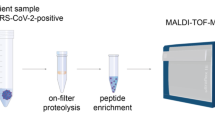Abstract
Fluorescence detection has been a method of choice in industry for screening assays, including identification of enzyme inhibitors, owing to its high-throughput capabilities, excellent reproducibility, and sensitivity. Occasionally, inhibitors are identified that challenge the fluorescence assay limit, necessitating the development of more sensitive detection methods to assess these compounds. For data mining purposes, however, original assay conditions may be required. A direct method transfer to highly sensitive and specific LC-MS-based methods has not always been possible due to the presence of MS-incompatible neutral detergents and non-volatile salts in the assay matrix. Utilizing an in vitro proteolytic screening assay for the serine protease hepatitis C virus (HCV) nonstructural (NS) 3 protease as a test case, we report the development of an automated sample clean-up procedure implemented on-line with liquid chromatography–tandem mass spectrometry (LC-MS/MS) analysis to complement fluorescence detection. Ion exchange and peptide microtraps were employed to remove MS-incompatible assay matrix components. Three protease inhibitors were used to validate the MS/MS method. Comparable potencies were achieved for these compounds when assessed by fluorescence and MS/MS detection. Furthermore, four-fold less enzyme could be utilized when employing the MS/MS method compared to fluorescence detection. The longer analysis time, however, resulted in reduced sample capacity. The potency of our designed HCV NS3 protease inhibitors are thus routinely evaluated using a continuous fluorescence-based assay. Only pertinent inhibitors approaching the fluorescence assay sensitivity limit are subsequently analyzed further by LC-MS/MS. This methodology allows us to maintain a database and to compare results independent of the detection method. Despite the relatively slow sample turnaround time of this LC-MS approach, the versatility of the automated on-line clean-up procedure and sample analysis can be applied to assays containing reagents which were historically considered to be MS incompatible.





Similar content being viewed by others
References
Kraut J (1977) Annu Rev Biochem 46:331–358
Sarath G, De La Motte RS, Wagner FW (1989) Proteolytic enzymes: a practical approach. In Beynon RJ, Bond JS (eds) IRL Press, Oxford, UK, pp 25–55
Hellen C (1994) Methods Enzymol 241:46–58
Rust L, Messing CR, Iglewski BH (1994) Methods Enzymol 235:554–562
Grant SK, Sklar JG, Cummings RT (2002) J Biomol Screen 7:531–540
Nikiforov TT, Simeonov AM (2003) Comb Chem High T Scr 6:201–212
Newman M, Josiah S (2004) J Biomol Screen 9:525–532
van Elswijk DA, Diefenbach O, van der Berg S, Irth H, Tjaden UR, van der Greef J (2003) J Chromatogr A 1020:45–58
de Boer AR, Letzel T, van Elswijk DA, Lingeman H, Niessen WMA, Irth H (2004) Anal Chem 76:3155–3161
Schenk T, Appels NMGM, van Elswijk DA, Irth H, Tjaden UR, van der Greef J (2003) Anal Biochem 316:118–126
Liesener A, Karst U (2005) Analyst 130:850–854
Schlueter H, Jankowski J, Rykl J, Thiemann J, Belgardt S, Zidek W, Wittmann B, Pohl T (2003) Anal Bioanal Chem 377:1102–1107
Liesener A, Karst U (2005) Anal Bioanal Chem 382:1451–1464
Ohbayashi H (2002) Expert Opin Invest Drugs 11:965–980
Hauptmann J (2002) Eur J Clin Pharmacol 57:751–758
Kaiser B (2002) Cell Mol Life Sci 59:189–192
McPhee F, Yeung K-S, Good AC, Meanwell NA (2003) Drug Future 28:465–488
Taliani M, Bianchi E, Narjes F, Fossatelli M, Urbani A, Steinkuehler C, De Francesco R, Pessi A (1996) Anal Biochem 240:60–67
Griffiths WJ, Jonsson AP, Liu S, Rai DK, Wang Y (2001) Biochem J 355:545–561
Shen T-L, Noon KR (2004) Methods Mol Biol 251:111–139
Loo JA, Kilby GW (2002) Pract Spectrosc 32:251–281
Trauger SA, Webb W, Siuzdak G (2002) Spectroscopy 16:15–28
John H, Walden M, Schafer S, Genz S, Forssmann W-G (2004) Anal Bioanal Chem 378:883–897
Bischoff R (2003) Anal Bioanal Chem 376:289–291
Steen H, Mann M (2004) Nat Rev Mol Cell Biol 5:699–711
Lill J (2003) Mass Spectrom Rev 22:182–194
Ashcroft AE (2003) Nat Prod Rep 20:202–215
Swiderek KM, Alpert AJ, Heckendorf A, Nugent K, Patterson SD (1997) in Tricks of the Trade. ABRF News 8, http://www.abrf.org/ABRFNews/1997/December1997/dec97detergent.html
Souverain S, Rudaz S, Veuthey J-L (2004) J Chromatogr A 1058:61–66
James CA, Breda M, Frigerio E, Long J, Munesada K (2002) Chromatographia Suppl 55:S41–S43
Hopfgartner G, Bourgogne E (2003) Mass Spectrom Rev 22:195–214
van Hout MWJ, Niederlander HAG, de Zeeuw RA, de Jong GJ, pp 1–44 in Wilson ID (2003) (ed) Handbook of Analytical Separations, Bioanalytical Separations, 4 (Bioanalytical Separations). Elsevier Science, New York, NY, USA
Souverain S, Rudaz S, Veuthey J-L (2004) J Chromatogr B: Anal Technol Biomed Life Sci 801:141–156
Stoney K, Nugent K (1994) in Proceedings of the 42nd ASMS Conference on Mass Spectrometry and Allied Topics, p 630
Nugent K, Scott W, Carrier M (1998) ABRF’98, San Diego, CA, March 21–24
Gustavsson SA, Samskog J, Markides KE, Langstroem B (2001) J Chromatogr A 937:41–47
Acknowledgements
The authors would like to acknowledge Leap Technologies, Carrboro, NC and Michrom Bioresources, Inc., Auburn, CA for their assistance in the programming of the switching valve procedures and in setting up the conditions for the microtraps.
Author information
Authors and Affiliations
Corresponding author
Rights and permissions
About this article
Cite this article
Drexler, D., Barlow, D.J., Falk, P. et al. Development of an on-line automated sample clean-up method and liquid chromatography–tandem mass spectrometry analysis: application in an in vitro proteolytic assay. Anal Bioanal Chem 384, 1145–1154 (2006). https://doi.org/10.1007/s00216-005-0263-7
Received:
Revised:
Accepted:
Published:
Issue Date:
DOI: https://doi.org/10.1007/s00216-005-0263-7




